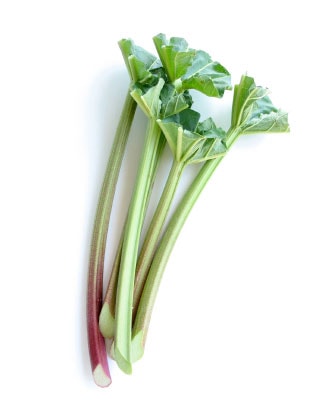
Written By: Sofia Layarda, MPH
Title: Master of Public Health
Alumni: University of California, Berkeley
Last Updated on:

Although classified as a vegetable, rhubarb is often treated like a fruit in the kitchen. Popular in jams, jellies, and baked goods (muffins or pies), the stalk becomes soft and tart when cooked. In case you have never seen rhubarb, at first glance it looks like a bright red celery stalk (although it lacks the definite “ribbing” that celery has). The plant also comes in a green variety, but red rhubarb is the one you will likely find in stores. The leaves of the plant contain substances that are considered toxic, so never eat them.
Table of Contents

Rhubarb is low in calories and high in fiber, and is a source of Vitamin K (which has an important role in blood clotting). A cup of diced rhubarb provides 1/3 of the daily recommended intake of this vitamin. Some studies show Vitamin K also helps maintain strong bones in the elderly.
When buying rhubarb, look for firm stalks with no blemishes or squishy spots. Trim and discard leaves and wrinkled stalk ends. The stalks will keep for a few days in the refrigerator, or can be frozen raw (cut them into 1-inch pieces for ease of use later on). Rhubarb is extremely tart, and therefore requires quite a lot of sugar to “undo” its sourness. If you are watching your sugar intake, try using rhubarb in a recipe that uses rhubarb’s tartness to its advantage instead of dousing the sour taste with sugar.
Alumni: University of California, Berkeley – Sofia believes in bringing back fun and pleasure into everyday eating. She loves cooking, and is constantly experimenting with ingredients, creating recipes and trying them out on family and friends. Her latest interest lies in finding realistic and practical ways of environmentally-friendly food/eating habits.
fiber, fruits, grocery aisle, healthy every month, , vegetables
Beyond Butter Chicken: What Real Indian Cuisine is Truly About – Podcast